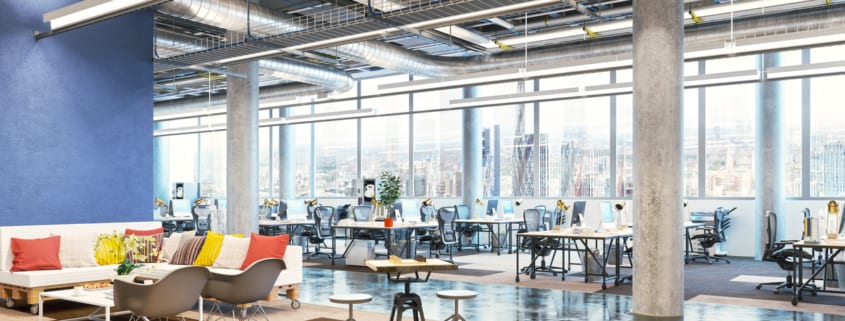How Workplace Evolution is Driving the Placemaking Trend
Today’s workplace has completely evolved from the traditional office space (cubicles, private offices, and coffee pots) to one that provides employees with tools and amenities that are reminiscent of the comforts of home (couches, laptops, and snack bars). The atmosphere created by modern workplaces fosters collaboration, creativity, and productivity, leading employees to enjoy spending time at work and driving CRE developers to create unique office spaces.
Read ahead to learn how the CRE industry can leverage the principles of placemaking when developing and improving office space and what factors are driving this trend in commercial real estate.
What is placemaking?
According to CBRE, placemaking is the process of “integrating design, amenities and community to create a unique space where people want to be”. The concept of placemaking is centered on observing, listening to, and understanding the people who live, work, and play in an area (in this case, in an office space).
Although the concept of placemaking typically refers to the development of complex mixed-use projects, it has recently gained relevance in today’s office spaces, leading to a rising trend that is becoming a top priority for corporate real estate leaders.
What is driving the use of placemaking in the office sector?
The concept of placemaking within the office sector is heavily influenced by major shifts in workplace demographics and beliefs about the workplace. The growing demand for modern spaces that provide experiences, amenities, and services, has driven commercial real estate developers and owners to focus on creating buildings and spaces that accommodate the needs of today’s office building tenants and occupants.
A Millennial-Dominated Workforce
Millennials account for a large portion of today’s workforce and it is predicted that by 2020 about 50% of the American workforce will belong to this cohort. As this generation continues to dominate the workforce, there has been a transition from the traditional office space to a modern, more home-like office that accommodates their needs, expectations, and working style. Placemaking serves as one way that companies who want to attract Millennial talent have responded to these generational demands.
According to a CBRE survey, Millennials consider the overall workplace experience, including office design and amenities, when selecting a place of employment. The survey also found that Millennials view offices as more than just a place of work but also as a community where they can relax, socialize, and engage in other activities. In fact, 21% of 18- to 24-year-olds have reportedly turned down job offers from companies lacking desirable office designs or amenities. Because of this, companies have begun placing higher values on social amenities such as tenant lounges and outdoor seating areas, which foster engagement opportunities amongst employees.
People spend most of their time in three places: home (“the first place”), work (“the second place”), and social situations (“the third place”). In today’s society, there is a growing belief amongst many employees that where you work and where you live should be equally important. For modern workers, this belief is largely due to the fact that many of them work flexible hours outside of the traditional 9-to-5, as well as have convenient, 24/7 access to technology, often causing them to work well past normal work hours. These factors contribute to the difficulty of maintaining a separation between work and personal life for many workers.
Because modern employees often have longer work hours, they typically expect companies to compensate them for additional time by providing on-site conveniences and luxuries. On-site fitness centers have become one of the more popular amenities offered by placemaking offices. These fitness centers are beneficial for both employees and companies as healthy employees are able to focus on productivity and results.
Also, because achieving a normal work/life balance can be challenging, it has become the norm for employees to desire the ability to work and play within the office. As such, companies are expected to provide amenities that create opportunities for employees to have fun at work. Encouraging play at work increases job satisfaction and employee happiness, which have been proven to drive productivity and increase revenue.
What does placemaking mean for the future of the office?
The placemaking trend focuses on the experiences and happenings within the office. Commercial real estate owners and developers are beginning to view placemaking as a way to get the most out of their assets while feeding growing tenant and occupant demands.
For now, co-working spaces are the leader of placemaking efforts in today’s workplace; they are able to provide occupants with amenities and services similar to that of placemaking but with no permanent attachment to that space. However, because placemaking takes a more people-centered approach to the planning, designing, and management of the building, this trend is expanding.
With the intention of placemaking in the office sector being to enhance the daily work experience and to foster a culture that extends beyond the building, this rising trend closely aligns with the type of work environment that many companies are working to create. Because of placemaking, many industries have begun evaluating their office needs and business metrics, placing recruiting and workplace retention as a top concern – even higher than the cost of rent.
To learn more about the evolution of the workplace and new office trends, read Why Office Buildings are Adapting to The Smart Building Trend.











